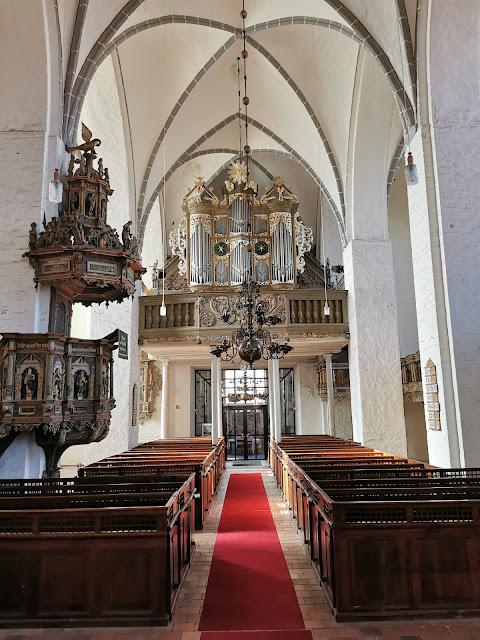On a sunny Sunday, I decided to do a day trip from Berlin and visit a few places east of the capital. I started our early by taking a train to Neustadt (Dosse). Once there, I got out of the train station and started walking northward until I reached the nearby village of Kampehl. Here I visited the local village church, the Dorfkirche Kampehl, built in the 13th century in fieldstone and partially refurbished during the 18th century. What's peculiar about this building though is that it holds, below ground level, in a small room next to the main church building, the family tomb of the von Kahlbutz family. Inside, in a glass case and as a tourist attraction, is the mummy of Christian Friedrich von Kahlbutz, a knight who died in 1702 at the age of 52. He is famous because of the state of preservation of his body while no noticeable mummification process was used upon his death shrouding it in an air of mystery. Legend has it that in 1690 as the lord of the land he took the bride of a shepherd from Bückwitz, but as she refused him he murdered the shepherd. Although there were no witnesses, the shepherd's bride, accused Kahlbutz of the murder and took him to court; however, as an aristocrat, he was then acquitted. Several years after, in 1783, the last of the von Kahlbutz line died and while the church was being renovated in 1794 the coffins in the church were to be moved to the cemetery. When the coffins were opened though, it was discovered that all of the corpses except that of the Knight Kahlbutz had decayed. The local populace at the time believed that it was God's punishment for the murder of the shepherd as ut had been said that Kahlbutz had sworn before the court, "It was not I, otherwise after my death my body will not decay". In the 1890s, Rudolf Virchow and Ferdinand Sauerbruch tested the mummy as did Charité, the largest university hospital in Europe, but all without success and it still remains a mystery as to why Kahlbutz's corpse has not decayed. One theory is that Kahlbutz suffered from some kind of illness, possibly tuberculosis which made him lose a great deal of blood before his death. He was then buried in an oak double coffin, which, combined with the loss of blood and lack of decay-accelerating materials in the soil, possibly prevented the corpse's bodily decay. I paid for the entry ticket and a friendly woman then gave me some pamphlets to read while I observed the interesting mummy. A small group of people then arrived and I tried to understand further as the woman then gave them an explanation in German. After the visit to that peculiar site, it was time for me to head on. I left the village and walked through the woods and open fields until I reached the next town, Wusterhausen. Once there I walked through the main square and headed on to the main church, St. Peter and Paul. It was built in a brick gothic style in the 14th century, from an earlier form dating from the previous century. It features a low thick bell tower attached to the front of the main hall nave. The interior was a mix of Gothic and Baroque, with traces of medieval frescoes, a Renaissance pulpit, a wooden crucifix from 1474, and the 18th-century baroque main altar and organ. After visiting the church I then walked around the rest of the old town, passing by some nice timber-framed houses. Then it was time to move on. I left Wusterhausen walking then along the shore of the Klempowsee. The trail ran along the western bank of the lake through a nice forest, and halfway up the body of water, I then decided to stop after finding a bench and eat the sandwich I had brought with me while admiring the view. After lunch, I continued along the shore and eventually reached a beach on the lake where I then turned westwards and left the lake and forest behind me soon after arriving in the town of Kyritz. Once there I walked along part of the surviving medieval walls which once fully encircled the old town, and then headed toward the center of town. I passed some nice timber-framed buildings, many dating from the 17th and 18th centuries, and reached then St. Mary's Church. Originally from the 12th century, it was rebuilt in the 14th century but burned down during the Thirty Years' War and rebuilt again around the beginning of the 18th century in a somewhat early neogothic style. Unfortunately, the church was closed so I could only see it from the outside. I walked then to the nearby Marktplatz, with the nice 19th-century brick town hall and all around its perimeter some old timber-framed houses as well as more modern ones. After one last walk around the rest of the old town, it was time to head to the train station from where I then took my train back to Berlin.
 |
| The way to Kampehl |
 |
| The church in Kampehl |
 |
| The Kalebuz knight mummy |
 |
| On the way to Wusterhausen |
 |
| The main square and church of Wusterhausen |
 |
| The interior of the church |
 |
| Fall colors and the Dosse river |
 |
| The Klempowsee |
 |
| Another view of the lake |
 |
| Fall colors |
 |
| A street in the old town of Kyritz |
 |
| The Marienkirche in Kyritz |
 |
| Kyritz's main square |
 |
| Old townhouses in the city center |














No comments:
Post a Comment